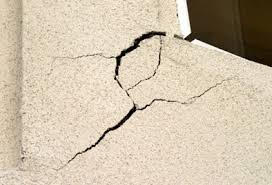Because stucco is a rigid material, it doesn’t flex or shift as your house ages. As seasonal changes cause small expansion and contracting in the materials that compose your home, the stucco is put under pressure in new ways. Additionally, a home can settle over time, sinking tiny amounts here and there. These shifts are normal, but they are not always friendly to your stucco. So when your house goes through these minor changes, the exterior stucco will begin to show cracks.
Unlike hairline cracks, a large stucco crack may indicate a structural problem. Often, large cracks develop at the intersection of vertical walls, at the upper corners of window and door frames, or at joints between wood framing and concrete/brick masonry. Since most large cracks aren’t only wide but also deep, they allow moisture and water to penetrate the building envelope and pass freely through walls.
The most “dangerous” cracks are typically wider than 1/16 inches, with edges that are no longer aligned parallel to each other. If the edge of a crack has moved in relation to the other edge, it may indicate unusual structural changes in your home. As an example, when the foundation settles more on one side of a house than on the other, it may create enough stress for stucco to crack. To correctly address and fix potential structural problems, it’s very important to investigate large cracks before any attempt is made to repair them.

